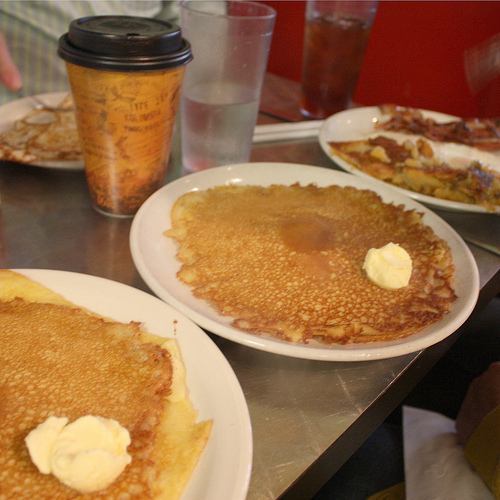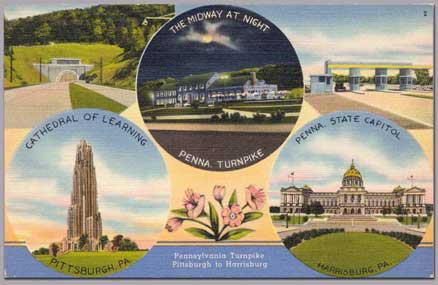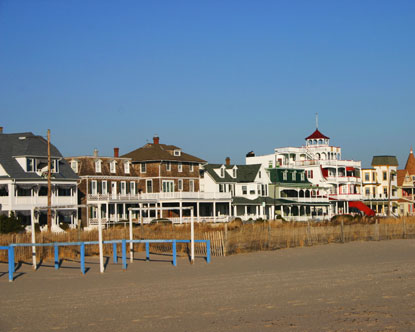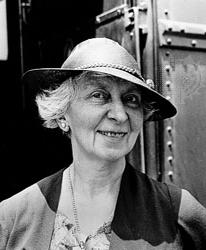 SUNDAY I asked my Twitter followers to suggest places to eat in Pittsburgh. Several of them said that Pamela’s Diner was a must, so we went there on Sunday for a pre-matinée brunch. I ordered chorizo and eggs with Lyonnaise potatoes and a short stack of crepe-style pancakes on the side, and I wolfed down every last bite on my plate. Likewise Mrs. T, who opted for her standard combo (bacon and eggs over easy) and was, like me, staggered by the accompanying pancakes, whose crispy edges melt on the tongue. I like haute cuisine as much as the next flâneur, but high-quality all-American diner food rings my bell just as loudly, and Pamela’s made it clang.
SUNDAY I asked my Twitter followers to suggest places to eat in Pittsburgh. Several of them said that Pamela’s Diner was a must, so we went there on Sunday for a pre-matinée brunch. I ordered chorizo and eggs with Lyonnaise potatoes and a short stack of crepe-style pancakes on the side, and I wolfed down every last bite on my plate. Likewise Mrs. T, who opted for her standard combo (bacon and eggs over easy) and was, like me, staggered by the accompanying pancakes, whose crispy edges melt on the tongue. I like haute cuisine as much as the next flâneur, but high-quality all-American diner food rings my bell just as loudly, and Pamela’s made it clang.
 After seeing the second installment of Pittsburgh Irish and Classical Theatre’s production of Alan Ayckbourn’s House & Garden, about which I raved a few days later in The Wall Street Journal, we drove halfway across Pennsylvania. The Pennsylvania Turnpike is a good-news-bad-news affair, a monstrously busy thoroughfare surrounded by green fields and forests. Mrs. T looked at the scenery, I at the traffic, and by the time we got where we were going, I was worn out.
After seeing the second installment of Pittsburgh Irish and Classical Theatre’s production of Alan Ayckbourn’s House & Garden, about which I raved a few days later in The Wall Street Journal, we drove halfway across Pennsylvania. The Pennsylvania Turnpike is a good-news-bad-news affair, a monstrously busy thoroughfare surrounded by green fields and forests. Mrs. T looked at the scenery, I at the traffic, and by the time we got where we were going, I was worn out.
Fortunately, our not-too-fancy roadside hotel somewhere in the middle of the state had a hot tub, which helped dispel the horrors of the journey. What’s more, we put two bucks in the soda machine and it promptly disgorged three bottles of Coke and change, which we did not return to the front desk. Honesty has its limits, especially after a long day on the road.
MONDAY We breakfasted at a Cracker Barrel across the parking lot from the hotel. Sneer if you must, but long experience as a road warrior has taught me that you can count on getting decent food and friendly service whenever you patronize a Cracker Barrel. The grits are only fair, but the hashbrown casserole is terrific, and you can also buy Goo Goo Clusters in the Old(e) Country Stores that are attached to every Cracker Barrel restaurant. Mrs. T, being a New Englander, had never eaten a Goo Goo. Now she knows what she’s been missing.
 After breakfast we returned to the road, and in mid-afternoon we arrived at Exit 0 on New Jersey’s Garden State Parkway, meaning that Cape May, the seaside resort town at the southern tip of New Jersey, was around the corner and over the bridge. Longtime readers of this blog know that I adore Cape May, a quaint little island village whose beach is lined with Victorian mansions that have been spruced up and turned into inns and guest houses. Mrs. T fell in love with Cape May the first time I took her there, and we’ve been going back ever since. So long as you don’t go at the height of the summer season, it’s cheery, companionable, surprisingly quiet, and nothing like the Jersey Shore of reality-TV renown.
After breakfast we returned to the road, and in mid-afternoon we arrived at Exit 0 on New Jersey’s Garden State Parkway, meaning that Cape May, the seaside resort town at the southern tip of New Jersey, was around the corner and over the bridge. Longtime readers of this blog know that I adore Cape May, a quaint little island village whose beach is lined with Victorian mansions that have been spruced up and turned into inns and guest houses. Mrs. T fell in love with Cape May the first time I took her there, and we’ve been going back ever since. So long as you don’t go at the height of the summer season, it’s cheery, companionable, surprisingly quiet, and nothing like the Jersey Shore of reality-TV renown.
 TUESDAY One of the blessings of my busy life as a peripatetic drama critic is that Cape May is home to two serious theater companies. Cape May Stage is performing Theresa Rebeck’s The Understudy, whose 2009 off-Broadway premiere impressed me so much that I’ve been wanting to see another production of the play to find out whether it has staying power. In addition, the East Lynne Theater Company has revived He and She, a rarely seen 1911 play by Rachel Crothers, a near-forgotten American playwright in whose work I’ve lately taken an interest. Having seen two of Crothers’ other plays mounted to memorable effect by New York’s Mint Theater, I was eager to find out whether this one was as good as Susan and God and A Little Journey, and East Lynne, like the Mint, specializes in giving a second chance to once-popular plays that have dropped off the scope.
TUESDAY One of the blessings of my busy life as a peripatetic drama critic is that Cape May is home to two serious theater companies. Cape May Stage is performing Theresa Rebeck’s The Understudy, whose 2009 off-Broadway premiere impressed me so much that I’ve been wanting to see another production of the play to find out whether it has staying power. In addition, the East Lynne Theater Company has revived He and She, a rarely seen 1911 play by Rachel Crothers, a near-forgotten American playwright in whose work I’ve lately taken an interest. Having seen two of Crothers’ other plays mounted to memorable effect by New York’s Mint Theater, I was eager to find out whether this one was as good as Susan and God and A Little Journey, and East Lynne, like the Mint, specializes in giving a second chance to once-popular plays that have dropped off the scope.
Given all this, it made sense for me to pay a working visit to Cape May this summer. Alas, there’s no easy way to get there from Pittsburgh, so Mrs. T and I decided to make the trip by car, then drive the rest of the way home to Connecticut. That adds up to seven hundred miles on the road. Don’t let anybody tell you that I’m not serious about covering regional theater!
(Second of three parts)
* * *
Bette Davis and Walter Pidgeon perform a radio adaptation of Rachel Crothers’ Susan and God on Screen Guild Theater, originally broadcast by CBS in 1946:
